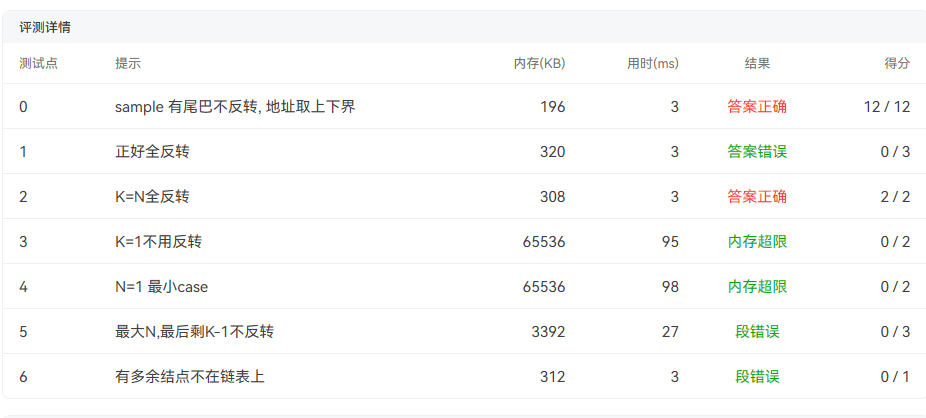|
|
马上注册,结交更多好友,享用更多功能^_^
您需要 登录 才可以下载或查看,没有账号?立即注册
x
太难了,还是这题!
给定一个常数K和一个单链表L,我们需要将L中每K个元素的链路进行反转。例如,如果L为1→2→3→4→5→6,如果K=3,则必须输出3→2→1→6→5→4;如果K=4,则必须输出4→3→2→1→5→6。
输入说明: 每个输入文件包含一个测试用例。对于每个测试用例,第一行包含第一个节点的地址,一个正整数N(≤100000),表示节点的总数,和一个正整数K(≤N),表示要反转的子链表的长度。节点的地址是一个5位非负整数,空指针用-1表示。
然后是N行,每行描述一个节点的格式为:
Address Data Next
其中Address是节点的位置,Data是一个整数,Next是下一个节点的位置。
输出说明: 对于每个测试用例,输出结果排序后的链表。每个节点占一行,并以与输入相同的格式打印。
Sample Input:
00100 6 4
00000 4 99999
00100 1 12309
68237 6 -1
33218 3 00000
99999 5 68237
12309 2 33218
Sample Output:
00000 4 33218
33218 3 12309
12309 2 00100
00100 1 99999
99999 5 68237
68237 6 -1
我更新后的代码:
- #include<stdio.h>
- #include<stdlib.h>
- typedef struct List *list;
- struct List
- {
- int address;
- int data;
- int last;
- list next;
- };
- list read(int n);
- void print(list head);
- void px(list head,int first);
- list dg(list p,list head,int i,int k);
- void print(list head)
- {
- if(!(head->next)){printf("NULL\n");return;}
- head = head->next;
- while(head)
- {
- if(head->last != -1)
- printf("%05d %d %05d\n",head->address,head->data,head->last);
- else
- printf("%05d %d %d\n",head->address,head->data,head->last);
- head = head->next;
- }
- }
- list read(int n)
- {
- list head,p,temp;
- head = p = (list)malloc(sizeof(struct List));
- head->next = NULL;
-
- while(n--)
- {
- temp = (list)malloc(sizeof(struct List));
- scanf("%d %d %d",&temp->address,&temp->data,&temp->last);
- p->next = temp;
- p = p->next;
- p->next = NULL;
- }
-
- // temp = head;
- // head = head->next;
- // free(temp);
-
- return head;
- }
- void px(list head,int first)
- {
- list p = head;
- list temp,temp2;
- int t = first;
-
- while(head->next)
- {
- if(head->next->address == t)
- {
- head = head->next;
- t = head->last;
- }
- else
- {
- p = head;
- while(p->next->address != t)
- {
- p = p->next;
- }
- list s;
- s = p->next;
- temp = s->next;
- s->next = head->next;
- head->next = s;
- p->next = temp;
- head = head->next;
- t = head->last;
- }
- }
-
- }
- void fz(list head,int k)
- {
- list p = (list)malloc(sizeof(struct List));
- p->next = head->next;
- list temp;
- int flag = 0;
- while(p->next)
- {
- int i = 1;
- temp = dg(p,p,i,k);
- if(!flag)
- {
- flag = 1;
- head->next = p->next;
- }
- //if(temp)
- p->next = temp;
- }
- }
- list dg(list p,list head,int i,int k)
- {
- if(!p)
- return p;
- list temp = NULL;
- list perv = NULL;
- if(i != k)
- {
- perv = p;
- p = p->next;
- i++;
- temp = dg(p,head,i,k);
- }
- else
- {
- head->next = p->next;
- temp = p->next->next;
- p->next->next = p;
- p->next->last = p->address;
- if(!temp)
- {
- list N = (list)malloc(sizeof(struct List));
- N->next = NULL;
- N->data = -1;
- return N;
- }
- return temp;
- }
- if(i == 2 && temp)
- {
- if(temp->data == -1)
- {
- list t = temp;
- temp = NULL;
- free(t);
-
- }
- p->next = temp;
- if(!temp)
- {
- p->last = -1;
- }
- else
- p->last = temp->address;
-
- }
- else if(temp)
- {
- p->next = perv;
- p->last = perv->address;
- }
-
- return temp;
- }
- int main(void)
- {
- list head;
- int first,n,k;
- scanf("%d %d %d",&first,&n,&k);
- head = read(n);
- //print(head);
- px(head,first);
- // print(head);
- fz(head,k);
- print(head);
- return 0;
- }
测试1:正好全反转 K%N = 0 的情况下!
答案错误
测试2:K=1不用反转
答案错误
测试3:最大N,最后剩K-1不反转
答案错误
测试4:有多余结点不在链表上
答案错误
测试5:试例
00100 6 4
00000 4 99999
00100 1 12309
68237 6 -1
33218 3 00000
99999 5 68237
12309 2 33218
答案正确
测试6:K=N全反转
答案正确
代码已经相较于之前做出修改,但是还有4个测试点过不了,想了一晚上想破脑袋了。求大佬帮帮忙!十分感谢!

|
|
 ( 粤ICP备18085999号-1 | 粤公网安备 44051102000585号)
( 粤ICP备18085999号-1 | 粤公网安备 44051102000585号)